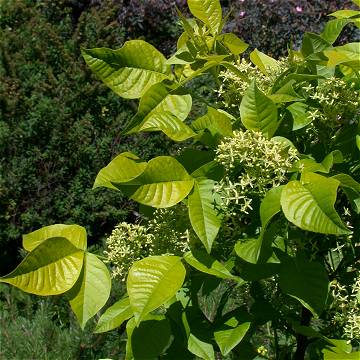

Ptelea trifoliata - (image 1 of 6)
Taxonomy
Family: Rosaceae
Habitat
Open areas along roadsides, fencerows, woodland edges. Rocky bluffs and slopes where limestone is near the surface. Dry woods. The variety mollis is a pant of sandy dunes near the great lakes, occasionally inland where dolomitic limestone is near the surface.
Associates
In dry woods with Agrimonia gryposepala, Aquilegia canadensis, Arabis laevigata, Carya cordiformis, Celtis occidentalis, Fraxinus americana, Herpatica acutiloba, Hydrophyllum virginianum, Laportea canadensis, Polygonum virginianum, Prenanthes alba, Prunus serotina, Quercus muhlenbergii, Quercus rubra, Smilacina racemosa, Solidago ulmifolia, Tilia americana.
On foredunes near Lake Michigan, P. trifoliata var. mollis occurs with Andropogon scoparius, Arctostaphylos uva-ursi coactilis, Artemisia caudata, Calamovilfa longifolia magna, Celastrus scandens, Cornus stolonifera, Euphorbia corollata, Juniperus communis, Lithospermum croceum, Prunus pumila, Prunus virginiana, Rhus aromatica arenaria, Rosa carolina, Smilacina stellata, Toxicodendron rydbergii, Vitis riparia.
Distribution
Mexico and southwest U.S., north and east to KS, southern WI, MI, Ontario, NC, and FL. Also irregularly to southern Quebec, VT, western NY, NJ, and VA.
Morphology
Small tree or large shrub to 20' high, deciduous. Leaves alternate, trifoliate; leaflets ovate to elliptic-oblong, to 4" long, the middle leaflet short-petiolulate; petiole to 3" long. Terminal bud lacking. Stems smooth, red-brown to gray, rounded, dotted; leaf scars U-shaped. Bark gray, smooth with short horizontal lenticels. Buds short, fuzzy. Flowers, greenish, to .5" wide, fragrant, in terminal corymbs to 3" wide; petals 4, rarely 5. Fruit a rounded, wafer-like samara, broadly winged, to 1" diameter, two-seeded.
var. mollis has lower leaf surfaces and branches densely pubescent. It is more southern with a range that extends north to D.C. and disjunct along the southern shore of Lake Michigan.
Notes
Flowers mid May to late June
Wetland indicator: Facultative Upland +, Upland (var. mollis)
Adaptable to sun and shade. Prefers good drainage. This tree could be used more as an ornamental, as there is always a need for small trees in the landscape. The fruits are astringent and have been used as a substitute for hops in making beer, hence the common name. Other names include Wafer Ash, Water Ash, and Stinking Ash. The latter name is probably in reference to the pungent odor emitted by bruised stems. The smell of the flowers is a little odd too.
The first two pictures are of the cultivar 'Aurea', a yellow-leaved selection. Images 3-4 are of var. mollis and were photographed at Indiana Dunes State Park.
References
Dirr, Michael A. 1998. Manual of Woody Landscape Plants:
Their Identification, Ornamental Characteristics, Culture, Propagation and Uses.
5th ed. Champaign, Illinois: Stipes Publishing L.L.C.
Gleason, Henry A. and A. Cronquist. 1991. Manual of Vascular Plants of Northeastern United States and Adjacent Canada. Second Ed.
The New York Botanical Garden. Bronx, NY.
Petrides, G. and J. Wehr. 1998. A Field Guide to Eastern Trees:
Eastern US and Canada, including the Midwest. 1st ed. expanded
Houghton Mifflin Co. Boston, MA
Swink, F. and G. Wilhelm. 1994. Plants of the Chicago Region.
Indiana Academy of Science. The Morton Arboretum. Lisle, Illinois.
|
Michael Hough © 2005 |